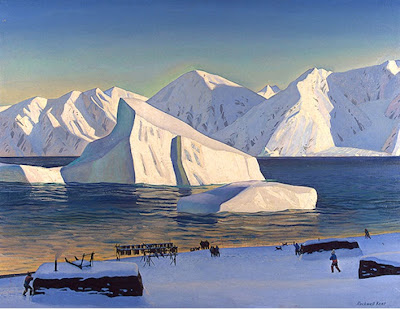"How to See" by Rockwell Kent
(photo courtesy Scott Ferris)
Here's a wonderful oil by Rockwell Kent, Early November, North Greenland, that I was fortunate to see in the Portland (Maine) Museum of Art a few years back. If you haven't seen this museum with its special focus on the art of New England, rest assured it's well worth a visit. (The painting was loaned from the State Hermitage Museum in St. Petersburg, Russia).
It's ironic I stumbled over an image of this piece just this morning while in my studio I'm working on a painting of mountains in Vermont. What draws me to Kent's painting is the sharp, crisp light blasting its way over these looming mountains and ice bergs. It reminds me ever so much of being a boy playing among the massive ice hills that would form along the shore of Lake Ontario as the winds drove the splashing water up onto the shore. Successive layers of new ice would coat whatever lay below forming mysterious hills and caves that reached way over our heads. It was a magical, if slippery, playground that's left a vivid memory impressed on my minds eye.
Kent's painting success stems from the many years he had trained himself to see the world. In turn when we take a close look at what he has done, we too train our eyes to see on a deeper level. Such is the power of art.
The entire painting is composed of various combinations of ultrmarine blue and a warmer color like raw sienna or burnt sienna, plus of course a lot of white. Kent deliberately chooses a mostly cool feeling to cover most of the canvas. While he uses warm colors they're deliberately held to a minority of the surface to make them seem more dramatic. They're also never allowed to express themselves as an intense orange. Instead Kent wants the blues and sometimes blue-violets to dominate the scene. I think in the hands of many other less able painters the work would have been overly colorful and come across as cheesy.
Notice how low in the sky the sun must have been. Kent had a life long fascination with the far north in part because he loved the long shadows that came from a sun that never rose that high in the sky. In all his marvelous wood engravings of figures (my favorite part of his artwork) that highly dramatic lighting is used to push drama into his works. And so it is here too.
Here's a detail that shows some of the fine tuning of the color reltationships. See how all the moutains in the background have highlights that are a little darker than the icebergs in the foreground (and a little warmer too). In the same vein see how the sky has been darkened down far enough to add umph to the highlights in the snow. The water of course is held very dark for the same reason.
This detail illuminates how simply Kent conceived of the volumes of his mountains. They're pared down from the complex and detailed forms they actually were to closely resemble simple geometric solids like four-sided pyramids and three-sided pyramids. Kent had to visualize them in his mind this way to create the feeling of their massive scale. The painting wonderfully expresses the feeling of "they are great but we are small." That's not a new theme in landscape painting, but it is brought to life by the visual talents of this very fine artist.
In my own case it was seeing Kent's engravings that illustrated his book N by E, that propelled me into working in a new way- imagining the painting based on drawings I'd done outdoors rather than painting in oil plein air. Much as I loved the work I'd done outside in oil I was prodded by Kent's example to reach a little harder for the spirit of the landscape in addition to the facts of the place I happened to be painting.
Here are the sources I'm working on right now in my studio. The vine charcoal drawing was done last June on location and the two small oils are from back in the studio. I'm working on expanded versions right now.







